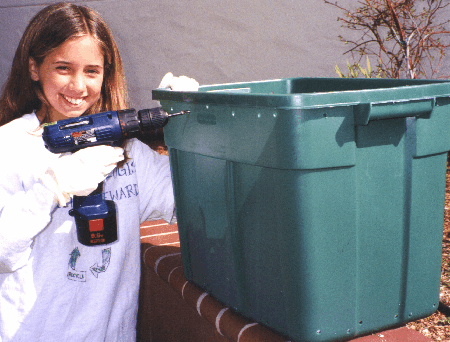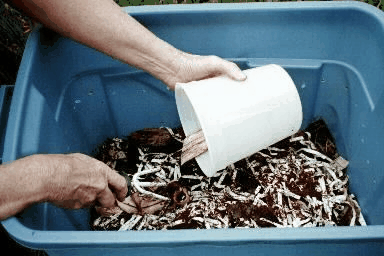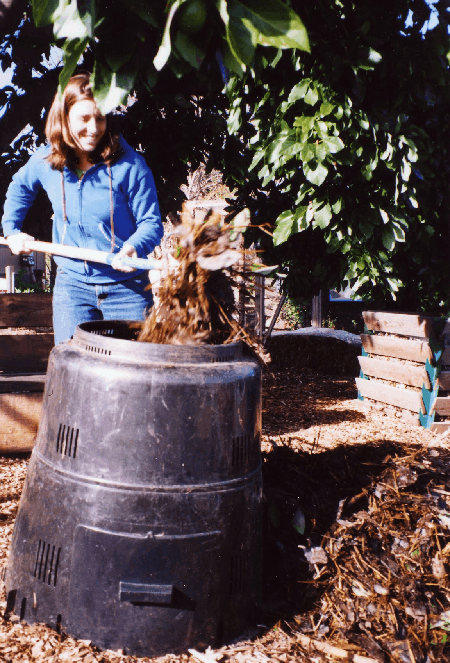- TABLE OF CONTENTS
- REDUCE YOUR WATER NEEDS
- Use Drought Tolerant Plants
- California Native Plants
- Climate Zones
- Reduce or Replace Lawn
- Artificial Turf
- IRRIGATE EFFICIENTLY
- Water Needs of Plants
- Before You Design
- Types of Irrigation Systems
- Weather Based Irrigation Controllers
- Working with an Irrigation Contractor
- DEVELOP ALTERNATE SOURCES OF WATER
- RETAIN WATER IN THE LANDSCAPE
- Build Retaining Walls
- Mulch to Reduce Evaporation
- Install Permeable Hardscapes
- Amend Soil with Organic Materials
- KEEP YOUR WATER PURE
- Drainage
- Eliminate Runoff and Overspray
- Slow it, Spread it, Sink it
- Ocean Friendly Gardens
- Rain Gardens
- Swales
- Keep Your Watershed Beautiful
- Soil
- Pests
- Select Plants that Don't Need Chemicals
- ADDITIONAL GARDENING RESOURCES
Amend Soil with Organic Materials
Composting
Composting, nature's own way of recycling, is the controlled decomposition of organic material, such as leaves, twigs, grass clippings, and vegetable food waste. Compost is a soil amendment that results from proper composting techniques. Composting saves water by helping the soil hold moisture, reducing evaporation and water runoff. Using compost as mulch will also benefit plants by keeping roots cooler. Composting also saves you money by lowering garbage bills and replacing the need for commercial soil amendments and fertilizers. Using compost in your garden also benefits your garden and container plants by improving the fertility and health of your soil. Plants that are grown in healthy soil are more resistant to pests and diseases. As a mulch, compost suppresses weeds and reduces the need for pest controls and sprays. Whether it's done on-site, at the point of waste generation, or in a large-scale, centralized facility, composting helps the environment by recycling valuable organic resources and extending the lifetime of our landfills.
The County of Santa Cruz has composting workshops on a regular basis, call (831) 423-HEAP or visit http://www.compostsantacruzcounty.org/ for more information about composting and free workshops.
Worm Composting
Worm composting can be done in the kitchen using food scraps. Click the link for further instructions and information on worm composting.
Bin/Pile Information
Composting can be practiced in most backyards using a homemade or manufactured composting bin, or simply an open pile.
In addition, businesses, schools, and other facilities can also easily compost.
Homemade bins can be constructed out of scrap wood, chicken wire, snow fencing or even old garbage cans (with holes punched in the sides and bottom).

Even a kid can do it.
This student drills hole for aeration in this soon to be worm bin at school.
Photo: Ecology Action
Manufactured bins include turning units, hoops, cones, and stacking bins. These can be purchased from retail or mail order businesses. The County of Santa Cruz has composting bins available for free. Visit http://www.compostsantacruzcounty.org/ for more information.
Biostack compost bin
Ingredients
While a multitude of organisms, fungus and bacteria are involved in the overall process, there are four basic ingredients for composting: nitrogen, carbon, water and air. Composting is a lot like cooking, and the easiest compost recipe calls for blending roughly equal parts of green or wet material (which is high in nitrogen) and brown or dry material (which is high in carbon). Simply layer or mix these materials in a pile or enclosure; chop or shred large pieces to 12" or shorter. Water and fluff materials to add air. Then leave it to the microorganisms which that will break down the material over time.

Adding nutrients to the worm compost bin.
Photo: Ecology Action
Nitrogen
Green materials, such as grass clippings and landscape trimmings, are ideal sources of nitrogen for composting. Vegetable and fruit trimmings and peels can also provide nitrogen. To reduce the potential for pests or odors, it is best to avoid meat or dairy scraps and bury any food scraps deep within the compost pile. Another source of nitrogen is horse manure.
Carbon
Brown (dry) yard and garden material, such as dry leaves, twigs, or hay, can provide the carbon balance for a compost pile. Chop or shred large pieces to 12 inches or shorter (thick, woody branches should be chipped, ground up, or left out). Untreated wood chips and sawdust are a powerful carbon source which that may be useful if the pile contains excess nitrogen. Remember, high carbon materials take time to decompose. This is normal and some materials may be in your pile for a long time before fully composted.
Water
One of the most common mistakes in composting is letting the pile get too dry. Your compost pile should be as moist as a wrung-out sponge. Moisture content of 40 to 60 percent is preferable. To test for adequate moisture, reach into your compost pile, and grab a handful of material, and squeeze it; if a few drops of water come out, it's probably got enough moisture, if it doesn't, add water. When you water, it is best to put a hose into the pile so that you aren't just wetting only the top. Don’t walk away and leave the water running too long though. You can also water as you are turning the pile. Be sure to use a shut-off nozzle for good spray distribution. During dry weather, you may have to add water more often. During wet weather, you may need to cover your the pile with a tarp to prevent it from becoming too wet. A properly constructed compost pile will drain excess water and should not become soggy.
Air
The bacteria and fungus that are in your compost pile need oxygen to live and work. If the pile is too dense or becomes too wet, the air supply to the inside is cut off and the beneficial organisms will die. Decomposition will slow and an offensive odor may arise. To avoid this and speed the process, turn and fluff the pile with a pitchfork often, perhaps weekly. You can also turn the pile by just re-piling it into a new pile; many composting bins make this easy to do by coming apart so you can easily re-pile the old pile back into the bin.
Size
Ideally, the compost pile should be at least three feet wide by three feet deep by three feet tall (one cubic yard). This size provides enough food and insulation to keep the organisms warm and happy and working hard. However, piles can be larger or smaller and work just fine if managed well.

Fluffing the compost is important for aeration
Photo: Ecology Action
Composting Techniques
Composting can be done "gourmet" style, requiring more effort, with quick results--or can be done more casually. Both ways will have a positive effect on the environment and produce usable compost. It just depends on how much time you want to spend with your compost pile and how fast you want the compost.
"Gourmet" compost piles that have the right blend of nitrogen (greens) and carbon (browns) and are kept moist and fluffed regularly and will heat up to temperatures of 120 to 170 degrees Fahrenheit. The high temperature will kill most weed seeds and speed up the decomposition process so that the compost may be ready in 2 to 3 months or less.
"Casual" compost piles are also quite workable since compost will "happen" even if you just pile on yard and food waste, water sporadically, and wait. The pile won't get as hot, so it won't decompose as quickly and may not kill weed seeds. Casual composting can take several months to a year.
How to Tell When it's Done
Your compost is finished when the original material has been transformed into a uniform, dark brown, crumbly product with a pleasant, earthy aroma. There may be a few chunks of woody material left; these can be screened out and put back into a new pile.
You may want to stop adding to your compost pile after it gets to optimal size (see above) and start a new pile so that your first pile can finish decomposing (during which time the temperature will drop).
Give it a Try! Home composting is best learned by doing. Through practice and observation you will find what works best for your home situation, and you can modify the process to suit your needs. There are also a number of books written on backyard composting; check the library or bookstore or click here to see online publications. Also check Santa Cruz County Composting website http://www.compostsantacruzcounty.org for workshops, and information about composting.
For more information:
Ask the Rotline! - Call (831) 423-HEAP
Worm Questions?
Ask the Worm Doctor! - Call (831) 427-3452